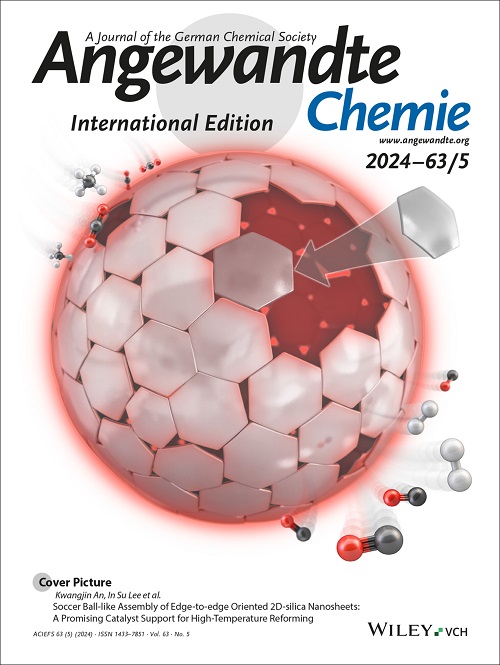Dual Co sites in n‐n type heterojunction enable selective electrochemical co‐valorization of HMF and CO2
IF 16.1
1区 化学
Q1 CHEMISTRY, MULTIDISCIPLINARY
引用次数: 0
Abstract
Electrocatalytic oxidation of biomass‐derived hydroxymethylfurfural (HMF) to 2,5‐furandicarboxylic acid (FDCA) and electrocatalytic reduction of CO2 into CO are two highly investigated areas. Efficient electrocatalytic system design that combines CO2 valorization with biomass upgrading offers a viable solution to produce high‐value chemicals and renewable energy at the same time. Here, we demonstrate an interfacial‐engineered CoS/Co‐N‐C n‐n type heterojunction featuring unique dual Co sites and strong built‐in electric field (BEF) effects, which enables efficient electrochemical coupling of 5‐hydroxymethylfurfural oxidation reaction (HMFOR) and CO2 reduction reaction (CO2RR). The optimized catalyst achieves exceptional performance metrics, i.e., a record‐low onset potential of 1.12 V (vs. RHE), with 99% selectivity and 98.2% faradaic efficiency (FE) for 2,5‐furandicarboxylic acid (FDCA) in HMFOR, coupled with 98.6% CO2‐to‐CO selectivity and the FE average was retained 98.4% in CO2RR, which outperform the previously reported state‐of‐the‐art electrocatalysts. Moreover, the integrated HMFOR//CO2RR system demonstrates impressive stability over 50‐hour continuous operation. Through systematic experimental examination and theoretical calculations, we reveal that the BEF boosts the formation of the unique dual Co coordination environments (Co‐N4 electron‐deficient and Co‐S electron‐rich configurations) through modulation of charge transport dynamics, facilitating HMF activation through *OH intermediate stabilization while promoting multi‐electron CO2 reduction via charge accumulation.n - n型异质结中的双Co位使HMF和CO2的电化学共价成为可能
生物质衍生羟甲基糠醛(HMF)电催化氧化制2,5 -呋喃二羧酸(FDCA)和CO2电催化还原成CO是两个备受关注的领域。高效的电催化系统设计将二氧化碳增值与生物质升级相结合,为同时生产高价值化学品和可再生能源提供了可行的解决方案。在这里,我们展示了一个界面工程的CoS/Co‐N‐C N‐N型异质结,具有独特的双Co位和强大的内置电场(BEF)效应,可以实现5‐羟甲基糠醛氧化反应(HMFOR)和二氧化碳还原反应(CO2RR)的有效电化学偶联。优化后的催化剂达到了优异的性能指标,即,创纪录的1.12 V的起始电位(相对于RHE),在HMFOR中对2,5呋喃二羧酸(FDCA)具有99%的选择性和98.2%的法拉第效率(FE),再加上98.6%的CO2 - to - CO选择性和平均FE在CO2RR中保持98.4%,这优于先前报道的最先进的电催化剂。此外,集成的HMFOR//CO2RR系统在50小时连续运行中表现出令人印象深刻的稳定性。通过系统的实验检验和理论计算,我们发现BEF通过调制电荷输运动力学促进独特的双Co配位环境(Co - N4缺电子和Co - S富电子构型)的形成,通过*OH中间稳定促进HMF活化,同时通过电荷积累促进多电子CO2还原。
本文章由计算机程序翻译,如有差异,请以英文原文为准。
求助全文
约1分钟内获得全文
求助全文
来源期刊
CiteScore
26.60
自引率
6.60%
发文量
3549
审稿时长
1.5 months
期刊介绍:
Angewandte Chemie, a journal of the German Chemical Society (GDCh), maintains a leading position among scholarly journals in general chemistry with an impressive Impact Factor of 16.6 (2022 Journal Citation Reports, Clarivate, 2023). Published weekly in a reader-friendly format, it features new articles almost every day. Established in 1887, Angewandte Chemie is a prominent chemistry journal, offering a dynamic blend of Review-type articles, Highlights, Communications, and Research Articles on a weekly basis, making it unique in the field.

 求助内容:
求助内容: 应助结果提醒方式:
应助结果提醒方式:


